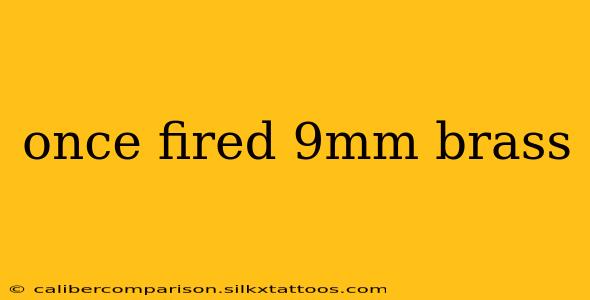Finding reliable sources for once-fired 9mm brass is crucial for both reloaders and collectors. This comprehensive guide delves into the intricacies of sourcing, cleaning, inspecting, and ultimately utilizing or preserving this valuable material. Whether you're a seasoned reloading enthusiast or just starting, understanding the nuances of once-fired 9mm brass will significantly impact your success and enjoyment.
Why Choose Once-Fired 9mm Brass?
Once-fired 9mm brass offers several advantages over new brass, making it a popular choice among reloaders and collectors:
- Cost-Effectiveness: Once-fired brass is significantly cheaper than purchasing new brass, representing substantial savings, especially for high-volume reloaders.
- Readily Available: The widespread popularity of the 9mm cartridge ensures a consistent and readily available supply of once-fired cases.
- Consistent Quality (Generally): Provided it's sourced responsibly and properly inspected, once-fired brass offers consistent performance, comparable to new brass.
Sourcing Once-Fired 9mm Brass: Where to Find It
Several avenues exist for acquiring once-fired 9mm brass:
1. Local Shooting Ranges:
Many shooting ranges allow collectors to pick up spent brass. This can be a cost-effective method but requires time, effort, and sorting through mixed calibers. Always check with the range's management for regulations and permission before collecting.
2. Online Marketplaces:
Online platforms like eBay and GunBroker offer a vast selection of once-fired 9mm brass, often sold in bulk quantities. Carefully review seller ratings and descriptions before purchasing to avoid receiving damaged or mixed brass.
3. Reloading Supply Stores:
Some reloading supply stores carry once-fired brass, either in bulk or smaller quantities. This offers convenience and ensures some level of quality control.
4. Private Sales:
Networking with fellow reloaders or firearm enthusiasts can lead to private sales of once-fired brass. This allows for direct transactions and often facilitates better quality control.
Inspecting and Cleaning Once-Fired 9mm Brass: A Crucial Step
Before using once-fired 9mm brass, thorough inspection and cleaning are essential:
1. Visual Inspection:
Carefully examine each case for:
- Significant dents or cracks: Cases with severe damage should be discarded.
- Primer pocket damage: Damaged primer pockets can lead to misfires and should be identified and addressed.
- Case head separation: Cases showing separation at the case head are unusable and must be discarded.
- Bullet deformation: If the bullet is still lodged in the case, this must be safely removed before any processing. Safety glasses are recommended during this process.
2. Cleaning Process:
Cleaning removes residue and prepares the brass for reloading:
- Tumbling: Using a rotary tumbler with media and cleaning solution effectively removes debris and oxidation.
- Hand Cleaning: For smaller batches, hand cleaning with a brush and solvent can be a viable option.
- Sizing: Once cleaned, resizing ensures uniform dimensions for proper reloading. This step is critical for safe and reliable function.
Beyond Reloading: Collecting Once-Fired 9mm Brass
For collectors, once-fired brass presents opportunities beyond reloading:
- Historical Significance: Depending on the source, the brass may offer a connection to specific events or historical periods, adding value for collectors.
- Condition and Rarity: Factors like manufacturer markings, headstamp variations, and the overall condition impact the collectibility of once-fired 9mm brass.
- Numismatic Value: Certain rare or unusual headstamps can increase the value of the brass over time. This aspect requires researching specific markings and their significance.
Conclusion: Maximizing the Value of Once-Fired 9mm Brass
Whether for reloading or collecting, once-fired 9mm brass offers a versatile resource. By understanding its sourcing, inspection, cleaning, and potential value, reloaders and collectors alike can maximize the utility and enjoyment of this readily available material. Remember safety is paramount when handling ammunition components. Always practice safe firearm handling techniques and follow all relevant safety regulations.

